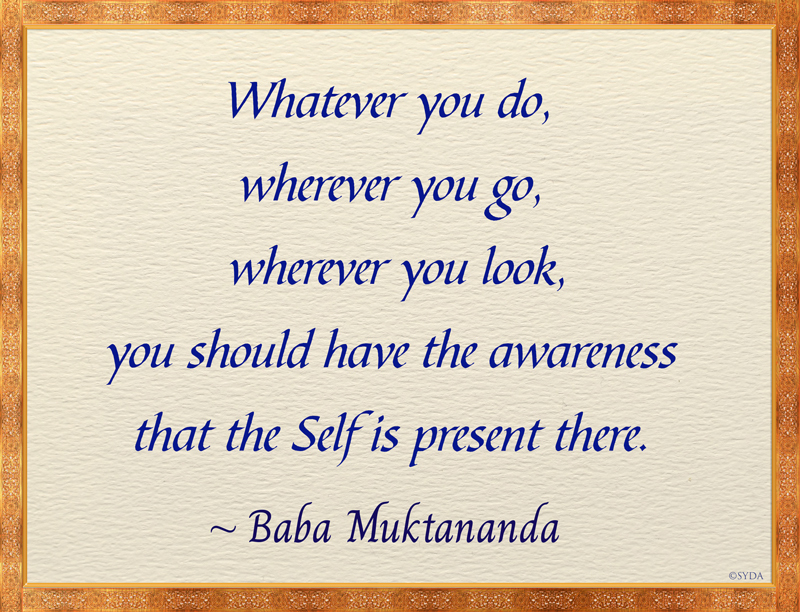Savoring Baba’s Words
Commentary IV

by Paul Hawkwood
Today you have the opportunity to reflect on a teaching from Baba Muktananda. Here are Baba’s words:
Whatever you do, wherever you go, wherever you look, you should have the awareness that the Self is present there.1
The words that Baba uses in this teaching are both simple and profound, and I will be explicating three of them: awareness, Self, and present. These three words are highly significant for your sādhanā, and reflecting on them can help you deepen your experience of the Self. See what insights arise within you as you learn about the meaning of Baba’s words.
Looking at the Three Terms

Baba first directs your attention to a core quality of your being: awareness. An important word in Sanskrit for “awareness” is बोध—bodha. This word comes from the root budh– which means, “to awaken, to understand, to be conscious, to know or to become aware.” The noun bodha means “awareness, understanding, knowledge, perception, or thought.” Bodha in this context means being aware and conscious of your own real nature, the Self, and the awareness that the Self is present in every aspect of this world.
Your experience of having this kind of refined awareness depends on how you use it. Do you experience the world—and yourself—through only your mind and physical senses? Or do you recognize that there’s something deeper present, something that is both within and beyond the physical world? Baba’s teaching encourages you to understand a far greater truth in your life: that the pure, radiant Self exists both within everything in this world and also as everything. How could anything exist but the Self?

Yet what is the Self? As you may have learned in the previous commentaries, the Sanskrit word for “the Self” is आत्मन्—ātman, the eternal, conscious essence of what you are beyond your personal history, your personality, and the contents and habits of your mind. The Vedas trace the word ātman to two Sanskrit roots: आत् āt-, meaning “that which moves or pervades everywhere,” and the root अन् –an, which means “to breathe.” The scriptures also state that you can experience the ātman by turning within and focusing on the pulsation of the pure “I am” that is the essence of every living being. As well, you can know that the ātman is the eternal reality that incarnates as each of us moving, breathing human beings. It is the Self that is the pulsating power behind all the movements, thoughts, and perceptions of your body, mind, and senses.

Baba’s teaching points toward another truth: in order to recognize that you are indeed the supreme Self, you must practice being present so that you can recognize the Self within you and within the world around you. A Sanskrit word for the term to be “present” is उपस्थित—upasthita. Upasthita also connotes “nearby, existing, approachable, close by.” Upasthita conveys the sense of being both physically close and also mentally present—existing fully in the mind and the heart. In the context of Baba’s teaching, upasthita indicates that the Self is present as you and as the entire world around you. I think of the Self as being as close as the air I breathe—it’s so near, so present, that I don’t even have to see it to know that it’s there.
Applying Baba’s Words
One way I practice Baba’s teaching is by frequently reminding myself to turn my awareness to the presence of the Self. Often, I do this by turning my attention to my heart region and focusing on the rise and fall of my breath as I repeat the mantra. I’ll mentally repeat the mantra with each in-breath and out-breath. When I focus on this, I experience a sense of peace begin to permeate my being. Connecting to the Self inwardly in this way helps me to then perceive the Self within the activity I’m engaged in, or the scene that is before me.
Another way I practice Baba’s teaching is by observing nature. I like to look at the clouds, which can appear to be divine brushstrokes dancing across the canvas of the desert sky. It’s easy for me to recognize the Self when I’m looking at this kind of beauty in the natural world.
I also remind myself that Baba’s instruction is to be aware that the Self exists in every aspect of my life, using the words “whatever” and “wherever,” which account for just about everything around me, including sights and situations that are neither beautiful nor pleasant—something I might see on my computer feed or on TV news. In such moments, I remember with heartfelt conviction the truth that this entire creation is a form of the Self, no matter what my mind thinks.
Then, I make the effort to acknowledge and respect the Self in that situation, individual, or scene. This doesn’t mean agreeing with what someone else is saying or with what is taking place. Yet I find it centering to remember that even if someone else may not recognize the Self, still the Self is that person’s very essence. Reflecting on this thought can bring me to the awareness that the Self is present right here, in this very moment or situation—just as Baba says.
With his words, Baba elucidates how you can recognize and keep the company of the Self throughout your day in whatever task you may be engaged in, and wherever you may be.
While you may or may not be able to change circumstances that you find difficult or even painful, you can take refuge in the peace and strength that arise from your bodha, your awareness, that the ātman, the Self, is always upasthita, present—as near as the air that surrounds and sustains you.
Let’s revisit Baba’s teaching:
Whatever you do, wherever you go, wherever you look, you should have the awareness that the Self is present there.
There are many ways you could put Baba’s teaching into practice in your daily life. One way to begin is by writing down and reflecting on the three main words Baba uses along with the corresponding Sanskrit terms: “awareness” (bodha), “Self” (ātman), and “present” (upasthita). As you explore the meaning of each word, consider how that word is a doorway that can open new perception to you in your sādhanā and daily life. Let your imagination reveal ways for you to understand and apply Baba’s words.
In your everyday interactions, find ways to recognize and appreciate the Self in whatever form it is manifesting. The Self is ever-present—can you find it? Experience it? Be it?
Just remember to pause in moments throughout the day to put Baba’s words into practice.



